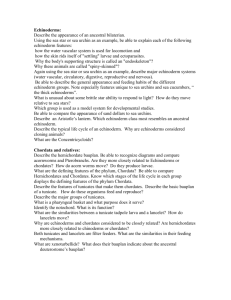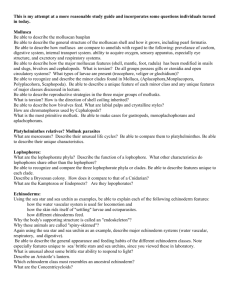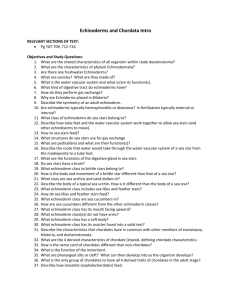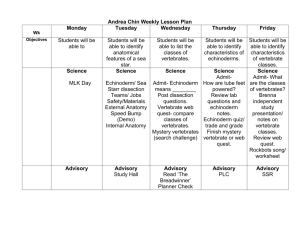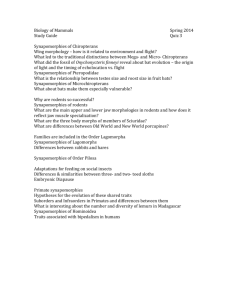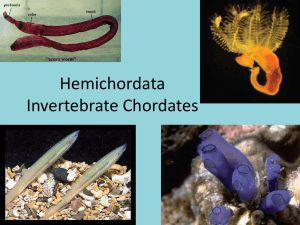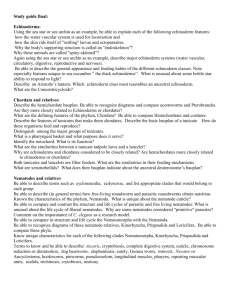study guide weeks 9-10 - Cal State LA
advertisement
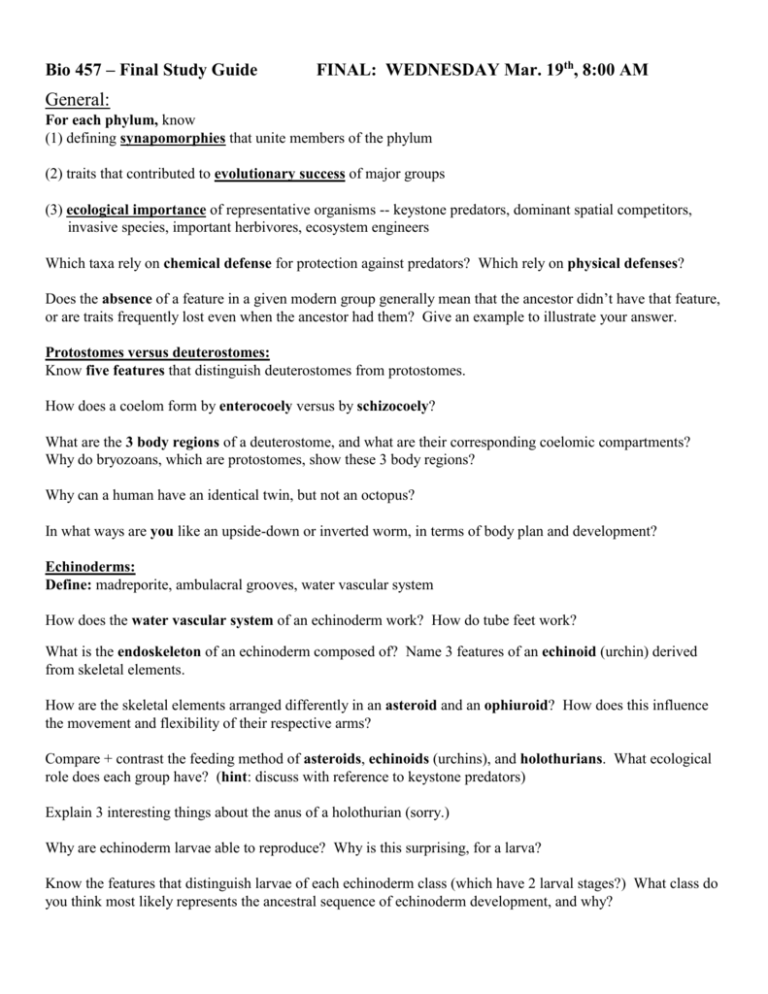
Bio 457 – Final Study Guide FINAL: WEDNESDAY Mar. 19th, 8:00 AM General: For each phylum, know (1) defining synapomorphies that unite members of the phylum (2) traits that contributed to evolutionary success of major groups (3) ecological importance of representative organisms -- keystone predators, dominant spatial competitors, invasive species, important herbivores, ecosystem engineers Which taxa rely on chemical defense for protection against predators? Which rely on physical defenses? Does the absence of a feature in a given modern group generally mean that the ancestor didn’t have that feature, or are traits frequently lost even when the ancestor had them? Give an example to illustrate your answer. Protostomes versus deuterostomes: Know five features that distinguish deuterostomes from protostomes. How does a coelom form by enterocoely versus by schizocoely? What are the 3 body regions of a deuterostome, and what are their corresponding coelomic compartments? Why do bryozoans, which are protostomes, show these 3 body regions? Why can a human have an identical twin, but not an octopus? In what ways are you like an upside-down or inverted worm, in terms of body plan and development? Echinoderms: Define: madreporite, ambulacral grooves, water vascular system How does the water vascular system of an echinoderm work? How do tube feet work? What is the endoskeleton of an echinoderm composed of? Name 3 features of an echinoid (urchin) derived from skeletal elements. How are the skeletal elements arranged differently in an asteroid and an ophiuroid? How does this influence the movement and flexibility of their respective arms? Compare + contrast the feeding method of asteroids, echinoids (urchins), and holothurians. What ecological role does each group have? (hint: discuss with reference to keystone predators) Explain 3 interesting things about the anus of a holothurian (sorry.) Why are echinoderm larvae able to reproduce? Why is this surprising, for a larva? Know the features that distinguish larvae of each echinoderm class (which have 2 larval stages?) What class do you think most likely represents the ancestral sequence of echinoderm development, and why? Be able to discuss echinoderm evolution. Understand that branches on a phylogeny represent evolutionary time and the history of a lineage. Show where, on this phylogeny, the following key evolutionary events occurred: (1) origin of pentaradial symmetry (2) opening or closing of ambulacral grooves (3) oral surface goes from pointing up to pointing down (4) origin or loss of 5 distinct arms Hemichordates: What synapomorphies do hemichordates share with chordates? Which are they missing? How are pterobranch hemichordates similar to bryozoans? Are these similarities synapomorphies or homoplasy (evolutionary convergence)? Chordates: What are the 3 major synapomorphies of chordates? Define each one. Which are present in a larval versus an adult ascidian? Compare and contrast how a coral, a giant clam, and a tropical ascidian use photosynthetic symbionts. Why do photosynthetic mutualisms arise repeatedly in different groups that live in tropical waters? What are 2 key ecological roles of larvaceans in ocean ecosystems? Define neoteny. How is this evident when examining the larvacean adult body? In what ways are ascidians similar to sponges? How are they different, and why? Compare suspension feeding in crinoids versus ascidians. Compare and contrast the anti-fouling defense mechanisms of a cheilostome bryozoan, an asteroid (sea star), and a colonial ascidian like the ones we saw in lab. Think about colonies. What convergent adaptations for colonial growth have we seen in different phyla? What are some advantages of growing as a colony, instead of as one large individual? Are you surprised that ascidians (Urochordata) are more closely related to chordates than amphioxus (Cephalochordata)? Which more closely resembles a fish as an adult? Metazoan relationships: What evidence was historically used to argue that annelids + arthropods were sister taxa? What evidence now indicates a closer relationship of molluscs + annelids, and nematodes + arthropods? Why are developmental control genes like Hox genes important for body plan evolution? What role has gene duplication played in the evolutionary diversification of bilaterian animals? Be able to indicate where major changes occurred in body plan evolution on a phylogeny of the animals. Be able to mark on branches where key features appeared such as multicellularity, tissues, mesoderm, and bilateral symmetry. What are two ways in which very distantly related taxa (like bryozoans and chordates) could share features? What is long-branch attraction and why did it pose problems for early analyses of metazoan relationship based on analysis of single genes like 18S? Explain how next-generation sequencing has revolutionized animal phylogenetics. Wht are the pros and cons of new sequencing technologies? What was the major controversial finding of the last big paper on metazoan relationships? What do you think the final answer will turn out to be? Big-picture question for the whole course Why makes some phyla or classes highly speciose (rich in species), while others are species-poor? Name the two most species-rich groups we studied, and name key traits that allowed each group to diversify into >100,000 species. Also, name one species-poor group, and explain why it was not as evolutionarily successful. Reasons for success (or failure) could be adaptive features (or limitations) of the body plan, range of ecological niches a group can exploit, and winning (or losing) the fight against a more efficient competitor. Hint: speciose groups usually include member species that (1) occur in marine, freshwater and terrestrial habitats, and (2) occupy many ecological niches so different species get their food in different ways; a group that includes predators, herbivores and filter-feeders will probably have more species than a group of only herbivores. Traits that protect against predators (or may you an effective predator) also contribute to species diversity. Where do the most species-rich phyla occur, and how diverse are their feeding habits?
